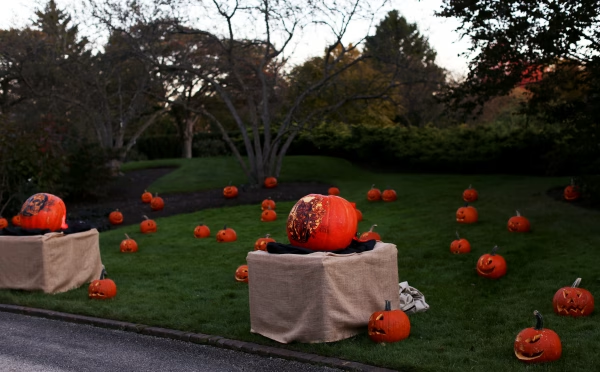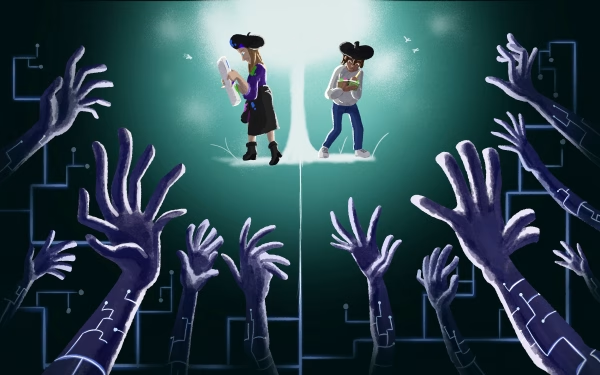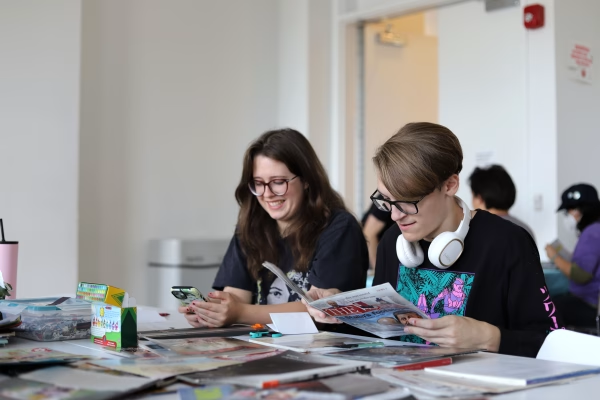Casual Instagram: New social media aesthetic accentuates the beauty of everyday moments
Luke Herman takes a photo of Fullerton Avenue as part of his Instagram page.

Bending over to take a picture with his iPhone, DePaul student Luke Herman snaps a photo of a used Dunkin coffee cup destroyed by snow on the sidewalk. Herman then gets up to take another photo of the busy street of Fullerton Avenue, a normally mundane street view of cars stuck in afternoon traffic. Neither of these photos would typically be considered art, but for Herman and many other young adults, it’s part of their instagram feed — and a new trend creating beauty in everyday items.
Herman has had an online profile since he was writing Harry Potter fan fiction in fourth grade. His online presence later expanded to Instagram, which showcased his daily life. From school dances to graduation, his online community got to watch the important moments right along with him.
“I feel like social media in general for my generation is a very consistent part of your life that’s hard to ignore,” Herman said. “I used to have a really curated Instagram, like I would get really excited about Homecoming Week and the perfect Homecoming photos. And then as time went on, really when Covid happened, that changed things a lot for me as far as, like, posting because I wasn’t doing anything anymore.”
The idea of going out and traveling was no longer possible for many during the pandemic, and because of that the use of Instagram needed to change for some users. Adapting to the new reality, people started posting day-to-day photos instead of milestone moments. Included in this is collections of ambiguous and slightly confusing photos compiled into one curated post.
“I feel this new style throws away the past vanity trend of Instagram models, with FaceTune and VSCO being the most important part,” said Herman. “The idea of putting effort into your Instagram was considered too extra, which nobody wants to be seen as anymore.”
With this new outlook of sharing your life, many people have opened up to expressing themselves in ways not normally presented on social media. The expectation of Photoshop and filters were thrown out the door to make way for a new trend of casual photos and random screenshots.
“What I really like about Instagram is you are in charge of how you are perceived,” Herman said. “I was using Instagram as a form of validation and I finally became self aware of how it made me feel.”
For Herman, this meant tuning into different art styles and being able to share more personal parts of his life. Throughout his profile you can see collections of party outfits, restaurants across campus and vague snaps of the train. Along with these photos include portrayals of recreating Marilyn Monroe portraits and detailed sceneries with rainbows, all personalized to the profile it was created for.
“I have a specific poem that resonates with how I feel moving to college and I added that as part of my collage of different photos representing fall quarter,” Herman said. “I feel like including more personal parts of myself along with busy ambiguous pictures truly shows more of me than beforehand.”
When asked how he feels he is perceived on instagram, Herman expresses a very common explanation of how instagram displays a more outgoing personality than truly expressed.
“I feel the way I am perceived is a lot more extroverted than I am. It’s hard to share a quieter version of yourself but I feel this new style of posting can express how introverted by the type of photos your post,” Herman said.
The term “casual Instagram” is defined as posting whatever you want and feel in the moment instead of what is usually presented through a fake persona. The recent terminology has been coined by Gen Z and has become a new opportunity for making a statement.
DePaul freshman Kaia Pierce, reflects throughout the years of how much Instagram has changed since she created a profile before fourth grade.
“I used to post memes and things that I thought were funny and like fourth and fifth grade were filled with cute pictures of cats and dogs and with mustaches,” Pierce said. “But then, you know, high school started and it transitioned to be more about me and my friends and more of what it is now.”
Since she first got an Instagram compared to now, Pierce feels casual Instagram is more about getting older and maturing and less about a new trend.
“I think that over time, especially as like our generation gets older, it’s really just gonna start getting less and less about how other people view, our online presence. By default, it’s just going to keep getting more casual,” said Pierce. “There’s always gonna be people who care and like putting the effort because they like it to be a certain way. But I don’t see people going back to the full time of everyone trying to be an Instagram model thing.
For some people, being yourself on Instagram isn’t anything new. For DePaul senior Angie Raney, Instagram has always been more of a private connection between personal friends than a display of public life.
“My profile is private so people have to request to see my photos, I don’t want my audience to be everyone,” Raney said. “I don’t think people have a right to see everything that’s going on in my life. And I think I get the right to choose who to share it with.”
For Angie’s Instagram, she used to never post as she felt she didn’t fit in with the specific style of edited and curated photos from before. Her pictures are filled with inside jokes, collections of happy people and funny memes at the end of the photo carousels. To her this is using Instagram in a way that’s better for her mental health.
“I like these pictures and I love using Instagram to be funny,” Raney said. “I used to be so preoccupied with what I looked like even outside of Instagram, like I used to really put a lot of thought about weight and how other people were perceiving me. So I think I’ve looked at using Instagram casually as a way of taking the narrative back.”
Growing up with Instagram can affect your perception of confidence and self, and created the idea of editing yourself in photos. Seeing only the good parts of people’s lives and the aesthetic of celebrities’ bodies can create insecurities of body image. Even today celebrities online form a whole separate life displaying their fortunes and expensive style. A study done in Computers in Human Behaviours reports social media sites are associated with disorder eating and poor body image outcomes for young adults.
For many people, Instagram is not a true portrayal of who you are as a person. The level of security through a screen can be edited to curate a specific persona not always seen in person. For DePaul sophomore Gracie Heneghan, Instagram portrays a rather accurate image of who she is in person.
“I’ve never really thought about it but I feel my profile gives a good indication of who I am. If someone looks at my profile you can easily see that I’m a DePaul student who lives in the city,” said Heneghan. “I also don’t heavily edit most of my pictures but I do feel I do think there are some things that go on in my life that I don’t post about, so I feel like for that reason it might not really show who I am truly.”
Henegan also feels that how people post about their lives still reflect only a level of who you really are compared to in person.
“I feel that my instagram only shows the positive times, such as when my friends and I go out, selfies and family pictures,” said Henegan. “I try not to post too much but when I do it’s only the happy times and I only post pictures if I feel really confident about it.”
The difference in what people post can also be affected by occupation and presence online. Raney holds a distasteful opinion on the idea of judgement towards each other just through a post online.
“I don’t think it’s fair to judge people on what they post because if that brings you joy, if that brings you confidence, I’m not going to tell you not to do it,” Raney said.
Instagram’s update of posting stories and multiple photos pushed the perspective of personalizing everything about your profile. And this also created a new opportunity of turning normal items into pieces of art.
“Everyone is an artist now. I feel like art is really personable and finding beauty in the little coffee cups or romanticizing all the parts of your life is vital,” Herman said.
Art is presented differently for many people. Sarah Huth, a junior at DePaul uses Instagram as a way to express herself through her love of photography and colors. Huth uses her major in film as well her style with clothes to create color blocks for each photo carousel. At the beginning of 2022, Huth compiled photos from the past year and grouped them into colors to create posts matching a specific color, putting a whole new idea on reflecting 2021.
“I really like colors and my closets are really colorful, and I really like colored things and I just think when I see things like that it’s just very stuck in my mind and [gives] a Wes Anderson vibe,” said Huth.
Huth prides herself on how different and fun her profile is to previous years. From her days of putting together a fake barbie account in middle school to taking enough pictures to fill a rainbow, Huth uses instagram to always express who she really is. One art piece she posted was of a fake wedding photoshoot with a friend to poke fun on how the two of them are commonly though of to be together.
“I bought this wedding dress. I was surfing and I bought this wedding dress and it was super big and complex wedding dress. And I set the scene when it was snowing outside and created a full photoshoot with my friend,” said Huth. “The colors together created such realistic photoshoot but it didn;t fool anyone that we actually got together.”
The transition of Instagram to become a self-expressive platform from the pandemic has created a whole new perspective of social media. From something that was once considered a harm to mental health and body image, this new trend is exploring a way to connect art to everyday lives.







